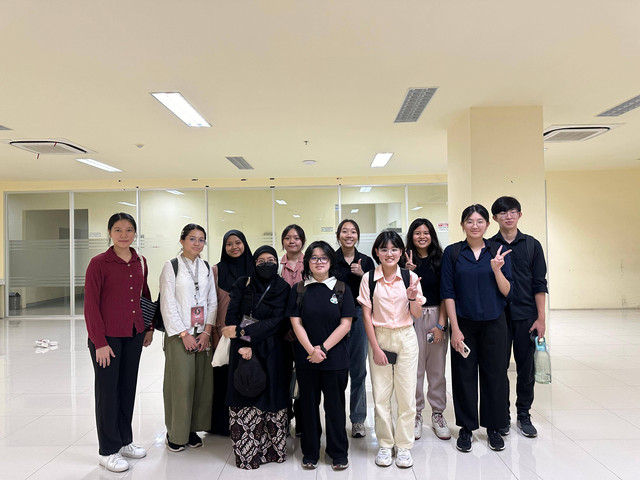Tentang KamiPedoman Media SiberKetentuan & Kebijakan PrivasiPanduan KomunitasPeringkat PenulisCara Menulis di kumparanInformasi Kerja SamaBantuanIklanKarir
2025 © PT Dynamo Media Network
Version 1.103.0
Konten dari Pengguna
Bridging Science and Compassion: A Holistic Approach to Animal Care in Veterinar
5 Januari 2025 16:57 WIB
·
waktu baca 6 menitTulisan dari Tiffany Natasha Junior 161241209 tidak mewakili pandangan dari redaksi kumparan
ADVERTISEMENT
In veterinary medicine, the convergence of advanced medical science and the human-animal bond is essential for delivering the best care possible to animals. However, beyond the skills and techniques of diagnosing and treating ailments, the true success of veterinary practice lies in the seamless integration of effective communication and innovative therapeutic strategies. These elements help not only in treating the animal but also in fostering trust, cooperation, and well-being for both the pet and their owner.

Building Trust Through Communication
ADVERTISEMENT
Empathy and Clarity in Veterinary Consultations
The cornerstone of any successful veterinary practice begins with communication. When pet owners walk into a clinic, they often carry a wealth of emotions and concerns about their animal's health. Veterinarians need to recognize this emotional connection and approach each consultation with empathy. Clear, jargon-free communication can ease pet owners' anxieties and help them make informed decisions about their pets’ care.
For example, when explaining a diagnosis like epilepsy, a veterinarian might say: "Your dog has a type of epilepsy where the cause is unknown, but we can manage it with medication to help control the seizures." This explanation not only conveys the seriousness of the condition but also reassures the owner that there is a manageable path forward.
ADVERTISEMENT
Moreover, active listening plays a crucial role in fostering a partnership with the pet owner. When veterinary professionals take the time to hear concerns, answer questions thoroughly, and provide emotional support, it helps in cultivating a relationship built on trust. This is not just about medical treatment but also about helping owners feel understood and involved in the healing process.
Collaboration Within the Veterinary Team
Communication extends beyond just the pet owner—it’s equally vital within the veterinary team. Whether through detailed case notes, team meetings, or digital platforms for information sharing, efficient internal communication ensures everyone is aligned and the animal receives the best care possible. A breakdown in this communication can lead to errors, compromising both the health of the animal and the trust placed in the clinic.
ADVERTISEMENT
Innovative Therapeutic Approaches for Holistic Care
Physical Therapies for Recovery and Comfort
Veterinary medicine has expanded beyond traditional diagnostics and surgery to embrace a variety of therapeutic techniques aimed at improving the quality of life for animals. Physical therapy, for example, is especially beneficial for post-operative recovery or for animals suffering from chronic conditions like arthritis. Techniques such as hydrotherapy, massage, and acupuncture are becoming more common in veterinary care to help with pain management and mobility.
Consider a dog recovering from hip surgery: under the guidance of a professional, the dog might use an underwater treadmill. This method provides gentle rehabilitation, allowing the dog to rebuild strength without putting undue pressure on its healing joints.
ADVERTISEMENT
Emotional Health: An Often Overlooked Element
While physical therapies are commonly integrated into treatment plans, emotional and behavioral health is an equally important facet of veterinary care. Animals can experience anxiety and stress, particularly when visiting the clinic or facing medical procedures. By introducing calming strategies—like pheromone diffusers, soft music, or a fear-free environment—veterinarians can help animals feel more at ease, which in turn supports their recovery and overall emotional well-being.
In fact, creating an environment that minimizes stress can significantly improve an animal's response to treatment, facilitating faster healing and reducing the risk of long-term psychological issues.
Alternative Therapies: A Complementary Approach to Healing
In recent years, complementary therapies have gained popularity in veterinary practices. These include treatments like herbal medicine, acupuncture, and low-level laser therapy, which provide additional relief for conditions such as arthritis or chronic pain. These therapies offer a holistic approach to healing that not only targets the physical symptoms but also enhances the animal's overall well-being, often in conjunction with traditional veterinary care.
Challenges in Implementation: Balancing Care with Practicality
Time Constraints and Financial Barriers
ADVERTISEMENT
While the benefits of clear communication and innovative therapies are undeniable, there are real challenges in implementing these practices in busy veterinary clinics. Time is often a limiting factor, and long consultations with clients may not always be feasible. To address this, veterinary teams can use educational materials like brochures or videos to supplement their discussions and ensure clients have access to the information they need.
Another challenge lies in the cost of some of the advanced therapies. Treatments like physical therapy or laser therapy can be expensive, and not all pet owners can afford them. To mitigate this, veterinary practices can prioritize essential treatments and offer flexible payment plans, ensuring that animals receive the care they need without causing undue financial strain on the owners.
ADVERTISEMENT
The Ripple Effect: Benefits Beyond the Animal
When veterinary clinics embrace effective communication and a holistic approach to care, the benefits extend far beyond the individual case. Owners who feel heard and supported are more likely to return for future care, and they are also likely to recommend the clinic to others. For the veterinary team, there is a greater sense of professional satisfaction, knowing that they are not only treating animals but also making a meaningful difference in their lives.
Additionally, animals receive more comprehensive and compassionate care, which promotes better outcomes in both the short and long term.
Conclusion: A Vision for the Future of Veterinary Medicine
The future of veterinary practice lies in a balanced approach that combines medical expertise, compassionate communication, and innovative therapies. By fostering open communication and embracing therapeutic strategies that address the physical, emotional, and even spiritual needs of animals, veterinarians can provide the highest quality of care.
ADVERTISEMENT
Though implementing these practices comes with challenges—time constraints, financial barriers, and the need for ongoing training—the rewards far outweigh the difficulties. Practices that prioritize clear communication, holistic therapies, and a compassionate approach will continue to thrive, ensuring that both animals and their caregivers experience improved health and happiness. The future of veterinary care is not only about treating illness but also about nurturing the deep bond between humans and their animal companions, creating a brighter future for all.

